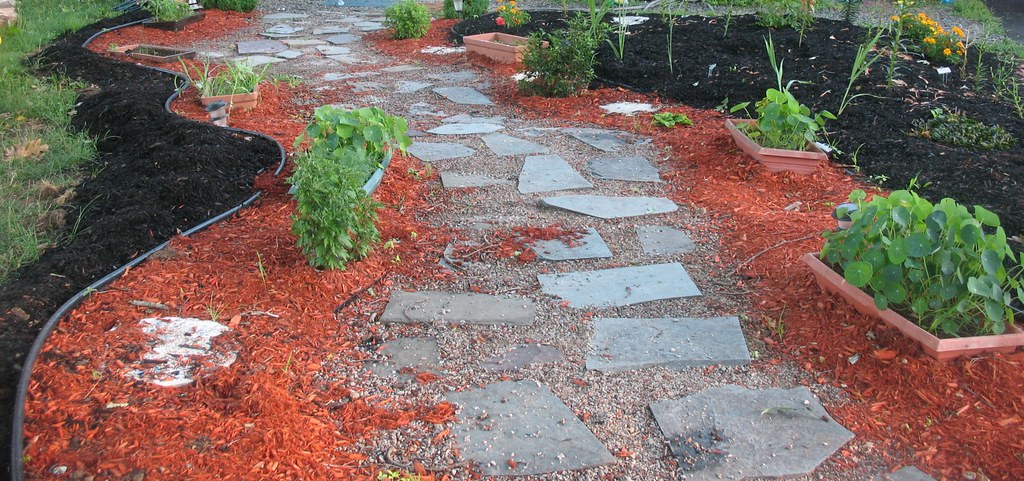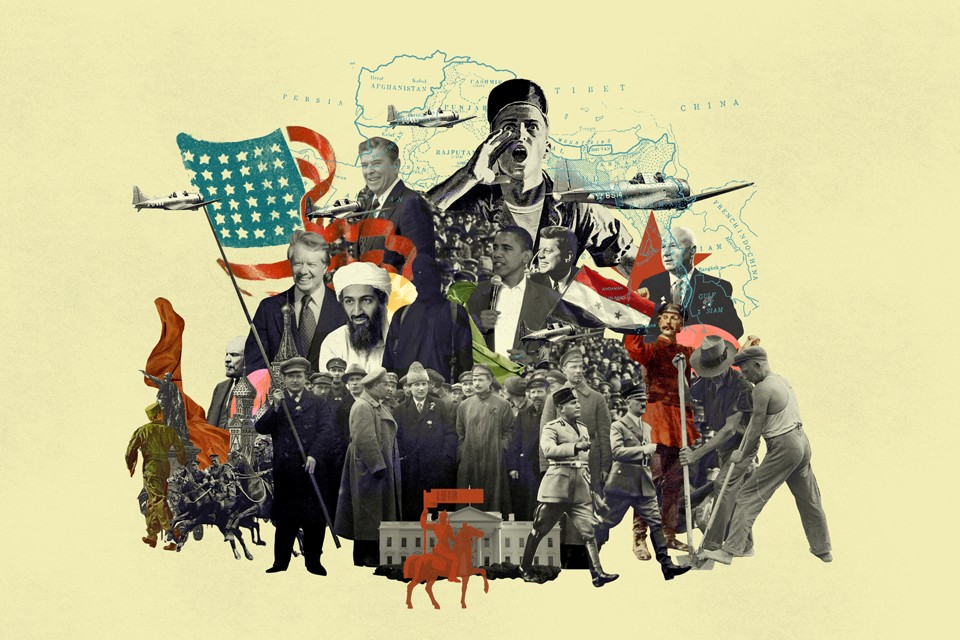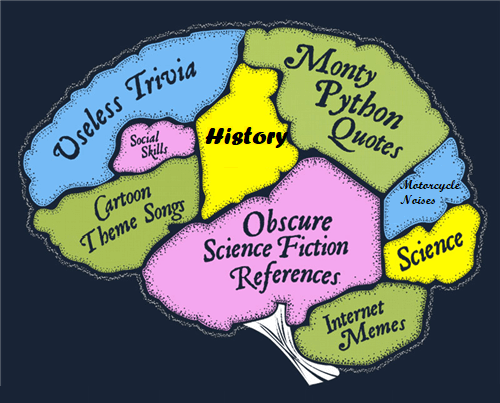Much of this describes what ideally happens in my classroom sans the museum, archival and preservation elements. Several years ago, in an effort to incorporate those elements and to address an oft-heard sentiment from students -- "I really love history, but I don't want to be teacher so I guess I can't pursue a career in history" -- I developed a proposal for a new course at the school where I teach called Applied History, a
semester-long class designed for a student interested in studying history in college or pursuing history as a career. The course will rely on in-depth historical interpretation and analysis (reading, researching and writing), while introducing students to the wide-range of possible careers in history besides the teaching of history: The essential theme of the course is that there is a "history" to everything and that there is a lot more one can do with history besides become an educator; one's interest or love of history can become a basis for a career. The course is hands-on, experience-based, and student centered following initial instruction/facilitation for each topic/unit from the instructor. Field trips to and guest speakers from a range of professionals, college and university programs, museums and historical societies and "virtual" field trips using numerous internet resources (e.g., Skype, conference calls, email, YouTube, Twitter, blogs, etc) will bring students into contact with a wide-range of historical experts and career possibilities.
While developing a proposal for this course I also corresponded with James Percoco, now retired from an award-winning career teaching at West Springfield High School in Springfield, Virginia and currently the Public Historian in Residence at American University. His classroom model is described in detail in two of his books, A Passion for the Past: Creative Teaching of U.S. History and Divided We Stand: Teaching About Conflict in U.S. History. Much of what Percoco places at the heart of the courses he taught was a hands-on and student-centered focus that sought to, as much as possible, get students out of the classroom to directly interact with historical sites, documents and artifacts. In his case, he relied heavily on his school's proximity to Washington DC to provide a great depth of first-hand learning experiences. While the DC-area does offer a unique set of museums, monuments and battlefields, Rhode Island has a fairly deep bench when it comes to historical sites and cultural resources -- not to mention Connecticut and Massachusetts both within easy field-trip range -- history is all around us!
My course rationale (excerpted below) focused on exploring the potential career option open to students with a passion for history:
Most students who like history and might otherwise consider a career in history are usually unaware of the other career opportunities for history beyond being a classroom teacher or college professor. Applied History seeks to give students hands-on, personal experience with a wide array of public history career opportunities while digging deeper into historical topics that the traditional US/World History course does not have the opportunity to explore. From this course students will gain an in-depth appreciation for all the ways that history is relevant to their lives and American society.The rationale included this direct quote from James Percoco:
“Today more opportunities are available in the history profession than ever before. No longer do you have to be a teacher when you study history. Jobs are available in the private sector as consultants. You can work in a museum or at an archives. At national and state historic sites you can be an interpreter, or participate in living history programs. These are only a few of the many possibilities. Many of the students who have gone through the Applied History course have indeed gone on to careers in history; a number have studied historic preservation at both the undergraduate and graduate level, while others have gone into anthropology and archeology.” (James Percoco, A Passion for the Past, page 13)And the proposed Curriculum Outline:
Unit I. Careers in History: Student interest inventory, “Everything and Everyone (including YOU) has a History”It was mentioned more than once to me during the approval process that this is a pretty ambitious curriculum for a one-semester high school course. The class would have necessarily been fast-paced, but the idea was cast a wide net and expose students to as many areas of history and potential career paths as possible, and let their interests dictate where they wanted to "drill down" into an area of particular interest through exhibits, projects and their journal.
Unit II. Origins and Memory: Genealogy, oral history, memory, narrative history, myth and storytelling
Unit III. Places. Public memory, monuments, and cemeteries; historic preservation (National Trust for Historic Preservation, Rhode Island Historical Preservation & Heritage Commission), tax-credits and restoration, (New England/US) history through architecture
Unit IV. Living History. Reenactments, docents, living historical communities (e.g., Plimouth Plantations, Sturbridge Village, Colonial Williamsburg); National Park Service; documentary film-making
Unit V. Public History. Museums and historical societies, collections management and curation, exhibits
Unit VI. The Nation. Military history, legal and constitutional history; the role and “uses” of history in nation-building and nationalism; coins, symbolism and the state
Unit VII. Social Science. sociology, anthropology, archaeology, history of language, linguistics and ethnology
Unit VIII. History and Science. Geology, paleontology, cosmology and “Big History;” history of math, science and technology
Unit IX. The Arts. Music history, art history, historical illustrations and photography, historically-themed theater and cinema
Unit X. Academic History. Teaching history, professional research, archives, rare books and special collections librarianship
Unit XI. Other Professionals. Real estate title-searches, genealogists, research consultants and think-tanks, document conservators, museum curators, lawyers and public administrators
Unit XII. The Future. Digital history and the digital historian.
Project-based Learning and Assessment
Students will generate a series of projects based on their interests to demonstrate their learning of course material, and share their discoveries via exhibits and presentations. Students will also create an electronic journal of their experiences in the class. The aim is to provide a “bridge” to a course of study in college in a number of possible career paths in public history, historic preservation, library and information studies, the social sciences and the humanities.
Unfortunately, despite the course gaining the approval of the history and guidance departments, building department heads and administrative team (the assistant principal backed my proposal mainly because I was so enthusiastic about it), the school improvement team, and the district curriculum planning council, it failed to get a recommendation from the district-level administration and hence the school committee did not approve it -- the final (and crucial) hoop to clear in the approval process. In any event, if there is a turnover in district administration or if outside events improved its prospects for approval, I hope to propose it again. For instance, if Applied History were to gain a higher profile at say, the national level, that could improve the odds of my course being adopted.
What if Applied History suddenly became a Cabinet-level position in the executive branch? An article in September 2016's The Atlantic, "Why the U.S. President Needs a Council of Historians" makes the very practical argument that "most Americans live in what has been called the “United States of Amnesia,”" especially policymakers. Starting with the example of how the lack of historical depth by neocons the George W. Bush administration led to the current cornucopia of problems in the Middle East, authors Graham Allison and Niall Ferguson go on to point out that the Obama administration's overconfidence in its historical knowledge presents an obstacle to formulating good policies, such as in our current relations with Russia, and propose a solution to the problem:
"President Obama’s inattention to the deep historical relationship between Russia and Ukraine led him to underestimate the risks of closer ties between Ukraine and Europe. “I don’t really even need George Kennan right now,” President Obama told The New Yorker for a January 2014 article, referring to the great Cold War–era diplomat and historian. By March, Russia had annexed Crimea.
To address this deficit, it is not enough for a president to invite friendly historians to dinner, as Obama has been known to do. Nor is it enough to appoint a court historian, as John F. Kennedy did with Arthur M. Schlesinger Jr. We urge the next president to establish a White House Council of Historical Advisers. Historians made similar recommendations to Presidents Carter and Reagan during their administrations, but nothing ever came of these proposals. Operationally, the Council of Historical Advisers would mirror the Council of Economic Advisers, established after World War II. A chair and two additional members would be appointed by the president to full-time positions, and respond to assignments from him or her. They would be supported by a small professional staff and would be part of the Executive Office of the President."
Historians are relevant because policy-makers and politicians often lack even a superficial understanding of the historical subtleties of any geographic region and, as Allison and Ferguson point out "historical analogies are easy to get wrong."
For example, they suggest that one of the reasons why current strategies at reversing the expansion of the Islamic State are ineffective is because of an analogical misunderstanding of the group. US policy-makers view ISIS as an offshoot of Al-Qaeda and have responded to its growth in a similar way, by taking out its leadership via drone strikes and supporting ground forces to drive it out of areas captured from failed states. But as an organization it would be more accurate to compare ISIS with "classic acephalous networks" such as the Bolsheviks, whose ideology and popular appeals resonated with people world-wide. But then what? Allison and Ferguson advise
"students and policy makers to follow a simple procedure: Put the comparison you are considering—for example, ISIS and the Bolsheviks—on a sheet of paper, draw a line down the page, and label one column “similar” and the other “different.” If you are unable to list three points of similarity and three of difference, you should consult a historian."Niall Ferguson has taken this idea one step further. He is also director of the Applied History Project at Harvard Kennedy School’s Belfer Center for Science and International Affairs. On the Applied History Project's website, (currently the fifth result on the first page in my Google search for the phrase "Applied History" -- due to Google analytics, your mileage may vary) in which he provides a definition of Applied History that does not consider the role of "public historians" in understanding the past but rather prioritizes the problem-solving potential of our discipline:
"Applied History is the explicit attempt to illuminate current challenges and choices by analyzing historical precedents and analogues. Mainstream historians begin with an event or era and attempt to provide an account of what happened and why. Applied historians begin with a current choice or predicament and analyze the historical record to provide perspective, stimulate imagination, find clues about what is likely to happen, suggest possible interventions, and assess probable consequences."Ferguson explains that his agenda is builds on the work of "two 20th-century giants: the modern historian Ernest May and the leading analyst of the American presidency, Richard Neustadt." He cites their 1986 book Thinking in Time: The Uses of History for Decision-Makers, as providing "the foundation on which we intend to build." (NB: Thinking in Time is available for $3.99 as an e-book on Amazon; it is now on my "next-to-read" list right after I finish The Men Who Lost America: British Leadership, the American Revolution, and the Fate of the Empire, coincidentally a brilliant case study in policy-making gone wrong. If only George III had had a Privy Council of Historical Advisers...)
Ferguson then proposes a manifesto for the creation of a White House Council of Historical Advisers. Ferguson sees the Council dealing with a range of issues and problems confronting policy-makers as well as responding to unexpected crises and emergency situations.
“Is it unprecedented?” is just one of a number of questions or assignments that we propose the President could give his Council of Historical Advisers. Others include:"...Of course," continues Ferguson, "building future scenarios is part of what intelligence agencies do. Yet, currently, historians play a very small part in this process. Applied historians do not have crystal balls. But they do have certain advantages over those who would try to answer such questions with models and regression analysis. They know that dramatic events that were dismissed as implausible before the fact are in hindsight frequently described as inevitable. Their study of previous sharp discontinuities encourages an “historical sensibility” that is attuned to the long-term rhythms, strategic surprises and daring coups de main that run through history."
- What lessons of statecraft from a former president’s handling of another crisis could be applied to a current challenge (“What would X have done?”)
- What is the significance of a historical anniversary for the present? (a common topic for presidential speeches)
- What is the relevant history of the state, institution, or issue at hand?
- “What if?” some action had not been taken (the kind of question too seldom asked after a policy failure)
- Grand strategic questions like “Can the United States avoid decline?”
- Speculative questions about seemingly improbable future scenarios.
If Ferguson's council ever becomes a reality, I will expand Unit VI of my course in Applied History to include "historical policy advisor" as a potential career path for students and resubmit the course for the approval process.
I for one support the creation of a White House Council of Historical Advisers with extreme prejudice.










